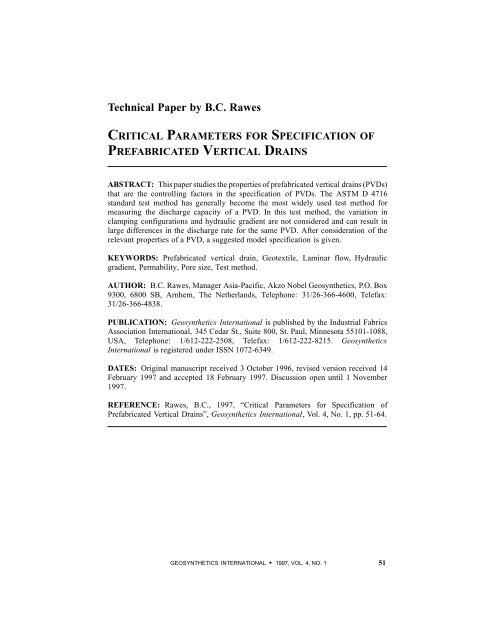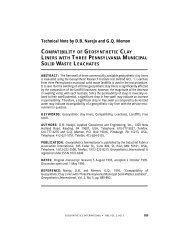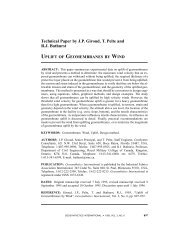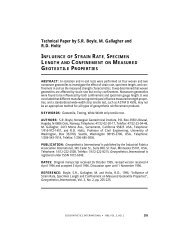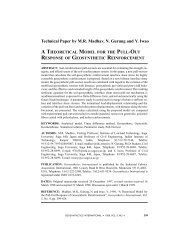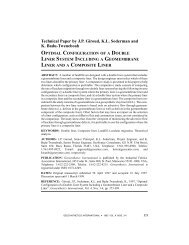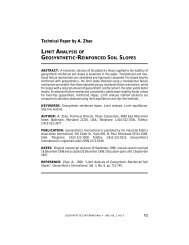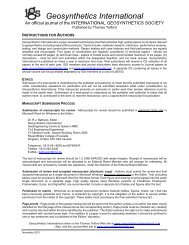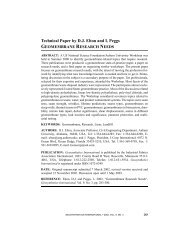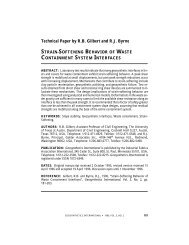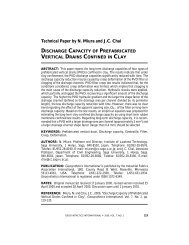Technical Paper by B.C. Rawes - IGS - International Geosynthetics ...
Technical Paper by B.C. Rawes - IGS - International Geosynthetics ...
Technical Paper by B.C. Rawes - IGS - International Geosynthetics ...
You also want an ePaper? Increase the reach of your titles
YUMPU automatically turns print PDFs into web optimized ePapers that Google loves.
<strong>Technical</strong> <strong>Paper</strong> <strong>by</strong> B.C. <strong>Rawes</strong><br />
CRITICAL PARAMETERS FOR SPECIFICATION OF<br />
PREFABRICATED VERTICAL DRAINS<br />
ABSTRACT: This paper studies the properties of prefabricated vertical drains (PVDs)<br />
that are the controlling factors in the specification of PVDs. The ASTM D 4716<br />
standard test method has generally become the most widely used test method for<br />
measuring the discharge capacity of a PVD. In this test method, the variation in<br />
clamping configurations and hydraulic gradient are not considered and can result in<br />
large differences in the discharge rate for the same PVD. After consideration of the<br />
relevant properties of a PVD, a suggested model specification is given.<br />
KEYWORDS: Prefabricated vertical drain, Geotextile, Laminar flow, Hydraulic<br />
gradient, Permability, Pore size, Test method.<br />
AUTHOR: B.C. <strong>Rawes</strong>, Manager Asia-Pacific, Akzo Nobel <strong>Geosynthetics</strong>, P.O. Box<br />
9300, 6800 SB, Arnhem, The Netherlands, Telephone: 31/26-366-4600, Telefax:<br />
31/26-366-4838.<br />
PUBLICATION: <strong>Geosynthetics</strong> <strong>International</strong> is published <strong>by</strong> the Industrial Fabrics<br />
Association <strong>International</strong>, 345 Cedar St., Suite 800, St. Paul, Minnesota 55101-1088,<br />
USA, Telephone: 1/612-222-2508, Telefax: 1/612-222-8215. <strong>Geosynthetics</strong><br />
<strong>International</strong> is registered under ISSN 1072-6349.<br />
DATES: Original manuscript received 3 October 1996, revised version received 14<br />
February 1997 and accepted 18 February 1997. Discussion open until 1 November<br />
1997.<br />
REFERENCE: <strong>Rawes</strong>, B.C., 1997, “Critical Parameters for Specification of<br />
Prefabricated Vertical Drains”, <strong>Geosynthetics</strong> <strong>International</strong>, Vol. 4, No. 1, pp. 51-64.<br />
GEOSYNTHETICS INTERNATIONAL S 1997, VOL. 4, NO. 1<br />
51
RAWES D Parameters for Prefabricated Vertical Drain Specification<br />
1 INTRODUCTION<br />
In the last 15 years, prefabricated vertical drains (PVDs) have almost completely replaced<br />
sand drains to accelerate the settlement of clay/silt soils under surcharge loading.<br />
The most important reasons for this change are listed below:<br />
S The installation rate of PVDs is typically 5,000 linear metres per day, which results<br />
in a significantly lower project cost.<br />
S There is no risk of PVDs breaking during installation, while sand drains may have<br />
discontinuities if the mandril is withdrawn too fast.<br />
S There is no risk of shear failure of PVDs during settlement, while sand drains are vulnerable<br />
to shear failure during settlement.<br />
S PVDs have high discharge capacities, typically 30×10 -6 to 90×10 -6 m 3 /s, while a<br />
0.35 m diameter sand drain has a discharge capacity of 20×10 -6 m 3 /s (Van Santvoort<br />
1994).<br />
S When installed with a properly designed mandril, smear effects are much less for<br />
PVDs than for large diameter sand drains. The zone of smear is directly proportional<br />
to the diameter of mandril used for installation.<br />
S PVDs are factory produced materials and are quality controlled, whereas sand drains<br />
are subject to the quality variance of naturally occurring sands.<br />
A generic PVD specification is urgently required in the industry. This is due in large<br />
part to the variable quality of the large number of PVDs available in today’s market.<br />
Many engineers are aware of this problem but may not have an in-depth understanding<br />
of PVDs. Often, engineers over-specify in design, using parameters that are not relevant<br />
to the performance of a PVD, while at the same time not enough attention is given to<br />
the critical parameters. This type of design specification may limit the choice of a PVD<br />
to one or two types that may not be competitive or suitable for the project. In this paper,<br />
the important functions of PVDs are addressed. The paper concludes with a thorough<br />
design specification for the requirements of a high performance PVD.<br />
2 PORE SIZE OF FILTER (GEOTEXTILE)<br />
Prefabricated vertical drains are <strong>by</strong> design, nearly always used in silts or clayey silts<br />
with a D 85 particle size of 15 to 30 µm. Therefore, it is necessary to have a fine pore size<br />
geotextile filter wrapping the core structure that will be compatible with the particle<br />
size distribution of the soil.<br />
There are a large number of geotextile filter criteria put forward in various publications<br />
between 1975 and 1985. This work was reviewed and critiqued <strong>by</strong> Fisher et al.<br />
(1990) and Bergado (1992). Fisher and Bergado have proposed the following criterion<br />
for the maximum pore size of the PVD geotextile filter based on the apparent opening<br />
size (AOS):<br />
AOS ≤ 75 μm<br />
(1)<br />
52 GEOSYNTHETICS INTERNATIONAL S 1997, VOL. 4, NO. 1
RAWES D Parameters for Prefabricated Vertical Drain Specification<br />
The ASTM D 4751 standard test method is a dry sieving technique that uses glass<br />
beads to determine the AOS of a geotextile. The test results in much larger O 95 values<br />
for the same geotextile than wet sieving or hydrodynamic sieving techniques that also<br />
use glass beads (Bhatia et al. 1994). When wet sieving is employed, the O 95 values can<br />
be as much as 50% smaller than the values obtained using ASTM D 4751. It should also<br />
be noted that ASTM D 4751 only measures down to a 75 μm particle size since below<br />
this size electrostatic forces between the glass beads would lead to an even greater variation<br />
between the results of wet and dry sieving test methods. However, the geotextile<br />
filter criteria are all empirical and are largely based on dry sieving techniques, hence<br />
the use of an AOS as a standard is acceptable to define the required O 95 value for the<br />
PVD geotextile filter. An O 95 value of 75 μm has been widely used over the last 15 years<br />
with good results, and in the light of the study <strong>by</strong> Bhatia et al. (1994), it can now be better<br />
understood why geotextile filters can retain silt particles in the size range of 15 to 30<br />
µm.<br />
3 PERMEABILITY OF THE FILTER<br />
A widely used criterion for geotextile filter permeability is as follows:<br />
k soil ≤ 10(k geotextile )<br />
(2)<br />
where: k soil = permeability of the soil; and k geotextile = permeability of the geotextile filter.<br />
This criterion is impractical for PVDs used in silt where the permeability of silts typically<br />
ranges between 10 -7 and 10 -10 m/s. Most geotextile filters have permeability values<br />
greater than 10 -4 m/s; therefore, Equation 2 is not applicable to conditions where the<br />
permeability of the soil is orders of magnitude smaller than the geotextile permeability.<br />
Such a large difference between the soil and geotextile permeability values should not<br />
be considered as a built in factor of safety because of the risk of geotextile clogging.<br />
There has been very little study of clogging and the resulting reduction of permeability<br />
of geotextile filters used in silts. In addition, it should be noted that some manufacturers<br />
of PVDs, in an effort to reduce manufacturing costs, have moved to the use of lightweight<br />
calendered geotextile filters (the calendering process melts the geotextile fibres<br />
into small, approximately 1 to 2 mm, diameter circles over the entire surface of the geotextile)<br />
to meet the O 95 specification. The direct result of calendering is to significantly<br />
reduce the permeability and reduce the O 95 size of the geotextile instead of increasing<br />
strength.<br />
4 DISCHARGE CAPACITY<br />
Over the past 10 years, more than 250 million linear metres of PVDs have been installed.<br />
During this time of considerable increase in PVD use, many researchers have studied<br />
the pore water discharge capacity of PVDs.<br />
One of the earliest studies conducted <strong>by</strong> Oostveen (1986) demonstrated, using actual<br />
site studies, that a maximum flow rate of 5×10 -6 m 3 /s existed in the PVDs investigated.<br />
GEOSYNTHETICS INTERNATIONAL S 1997, VOL. 4, NO. 1<br />
53
RAWES D Parameters for Prefabricated Vertical Drain Specification<br />
Koerner (1994) summarised in service PVD flow rate data; the maximum flow rates<br />
ranged between 1.5×10 -6 and 5×10 -6 m 3 /s (50 to 150 m 3 /year). These flow rates are<br />
based on actual site conditions, and thus, reductions in the discharge capacity of the<br />
PVDs caused <strong>by</strong> installation damage are incorporated in the flow rate values. Therefore,<br />
factors of safety are required when specifying a minimum discharge rate at a particular<br />
pressure. Particular consideration should be given to the effects of the following three<br />
main factors that cause a potential reduction of flow capacity:<br />
S deformation and creep of the geotextile filter into the core profile;<br />
S reduction of the permeability of the geotextile filter and deposition of fine particles<br />
in the core structure; and<br />
S reduction of the flow capacity due to kinking and bending of the PVD during settlement.<br />
Van Santvoort (1994) recommends that a PVD have a discharge capacity of 10×10 -6<br />
to 50×10 -6 m 3 /s at a confining pressure of 300 kN/m 2 if the PVDs in the field are greater<br />
than 10 m in length; and relative surface settlement is greater than 15% of the PVD<br />
length in less than 1.5 years. These required discharge capacities are in agreement with<br />
the information reported <strong>by</strong> Akagi (1994) (Figure 1). In Figure 1, the relationship between<br />
the minimum discharge capacity of the PVD, q wmin , PVD length and permeability<br />
of the clay/silt are shown. The data in Figure 1 is based on data from major Far East<br />
10000<br />
Discharge, q wmin (m 3 /year)<br />
1000<br />
100<br />
10<br />
1<br />
5 10 15 20 25 30<br />
Minimum drainage length of PVD (m)<br />
k 5×10 -8 h = m/s<br />
1×10 -8 m/s<br />
1×10 -9 m/s 5×10 -9 m/s 5×10 -10 m/s<br />
Figure 1. Minimum discharge capacity required for negligible flow resistance as a function<br />
of maximum drainage length of the PVD and horizontal permeability, k h , of clay/silt soil<br />
(after Agaki 1994).<br />
54 GEOSYNTHETICS INTERNATIONAL S 1997, VOL. 4, NO. 1
RAWES D Parameters for Prefabricated Vertical Drain Specification<br />
projects such as Changi Runway II, Chek Lap Kok and Changi-SIA Hanger in Singapore.<br />
In Figure 1, a q wmin value of 1000 m 3 /year (32×10 -6 m 3 /s) is obtained for a 30 m<br />
long PVD in a silt soil with a horizontal permeability, k h ,of1×10 -8 m/s.<br />
Koerner (1994) studied the use of partial factors of safety (FOS) to account for the<br />
reduction of PVD discharge capacity in site-specific cases. From the results obtained,<br />
an overall average FOS value of 18.0 was recommended to be applied specifically to<br />
the results of the ASTM D 4716 standard test method for obtaining an ultimate flow<br />
rate. This FOS value of 18.0, results in a PVD having a flow rate of 90×10 -6 m 3 /s at<br />
a confining pressure of 300 kN/m 2 as measured using ASTM D 4716 with solid loading<br />
platens, and assuming a minimum required flow rate of 5×10 -6 m 3 /s in the field. The<br />
flow rate of 90×10 -6 m 3 /s is a much higher value than that reported <strong>by</strong> Van Sanvoort<br />
(1994) because of the different test methods. In Van Sanvoort’s specification for required<br />
discharge capacity, it is assumed that the Delft test method is used, which allows<br />
for deformation and creep of the geotextile filter into the core structure. Thus, the required<br />
discharge rate specification is approximately half of the discharge rate using<br />
ASTM D 4716. The method used to establish the maximum flow rate of a PVD can give<br />
flow rate values at any given pressure that may vary <strong>by</strong> up to a factor of four. When<br />
testing a PVD for maximum flow capacity, the most important factors to consider are:<br />
S The duration of loading (minutes, hours or days).<br />
S The method of applying the load; solid steel clamps or foam rubber with a silt soil<br />
surcharge, or a neoprene sleeve and water pressure.<br />
S The hydraulic gradient; when the hydraulic gradient, i, exceeds 0.1, laminar flow may<br />
not be present.<br />
During the period 1975 to 1987, a working committee headed <strong>by</strong> Kremer and Oostveen<br />
made a detailed study of vertical drainage sponsored <strong>by</strong> the <strong>Technical</strong> University<br />
Delft, Public Works Department, The Netherlands, and the Road Construction Authority<br />
of The Netherlands. The results of this study have been a valuable source of formation<br />
to researchers. For example, a test method was proposed <strong>by</strong> Oostveen (1990) that<br />
replicates the in situ conditions for a PVD. A comparison was made between the compression<br />
of the PVD using clay/silt soil as a surcharge, and water pressure, with the PVD<br />
in a neoprene sleeve. The main disadvantage of using naturally occurring clay/silt is<br />
that the test results were not consistently repeatable and were difficult to perform. The<br />
use of a neoprene sleeve and water pressure for loading was found to be consistently<br />
repeatable and gave similar results to the clay/silt soil surcharge tests because the neoprene<br />
sleeve/water pressure assembly forced the filter into the core structure during the<br />
test. Figure 2 shows the schematic layout for the Delft PVD discharge test. The duration<br />
of the test is 28 days, during which the cell pressure is increased in steps of 50, 150, 250<br />
and 350 kN/m 2 with each pressure held constant for 7 days. The value of q w is determined<br />
at the beginning and end of each step.<br />
The Delft test also attempts to replicate the field conditions where only small quantities<br />
of water are actually discharged from the drain. Hence, water flow through the PVD<br />
is controlled between 2.5×10 -6 to 15×10 -6 m 3 /s and the head losses subsequently<br />
measured. From these readings and using Equation 3, a value of q w for each cell pressure<br />
can be calculated and related to a design Q value of 5×10 -6 m 3 /s which is the expected<br />
maximum flow in the field. Hence:<br />
GEOSYNTHETICS INTERNATIONAL S 1997, VOL. 4, NO. 1<br />
55
RAWES D Parameters for Prefabricated Vertical Drain Specification<br />
Reservoir<br />
Water outlet<br />
Pressure cell<br />
Water overflow<br />
Δh<br />
Flow gauge<br />
L<br />
Drain specimen<br />
(PVD)<br />
Latex membrane<br />
Water inlet<br />
Figure 2.<br />
Schematic layout of Delft PVD discharge test apparatus.<br />
q w = Q i<br />
(3)<br />
where: Q = water flow through the PVD; i = hydraulic gradient = Δh/L;andΔh = head<br />
loss over PVD length, L.<br />
In Figure 3, the results from a Delft test apparatus are presented and compared with<br />
results from an ASTM D 4716 test, and the NTU (Nanyang Technological University)<br />
drain tester on the same PVD material. The value of q w at a 350 kN/m 2 confining pressure<br />
varies between 35×10 -6 and 79×10 -6 m 3 /s. The NTU and the ASTM D 4716 test<br />
methods are described below.<br />
At the Nanyang Technological University of Singapore, a simple discharge capacity<br />
tester for PVDs (Broms 1994) was developed to provide a simple quality control test<br />
method for PVD projects in Singapore. In this test, the PVD is compressed, using site<br />
specific clay/silt material in contact with the PVD, in 100 kPa steps from 50 to 350 kPa.<br />
Each load step is held for one hour. The hydraulic gradient used as a reference for the<br />
results of the NTU test is i = 0.5, and the test is conducted to ensure laminar flow. Akagi<br />
(1994) noted the need to ensure laminar flow conditions and recommended a hydraulic<br />
gradient range for testing of i = 0.2 to 0.5.<br />
Let us now consider the ASTM D 4716 discharge test which has been the most commonly<br />
specified standard discharge test in recent years. First, it should be understood<br />
that the ASTM D 4716 test was developed for geotextiles but not specifically for PVDs,<br />
unlike the Delft test which is a purpose designed test to simulate field conditions.<br />
The most commonly used version of the ASTM D 4716 test (Figure 4) uses steel base<br />
and top platens covered with a thin rubber layer of low compressibility. This prevents<br />
any significant deformation of the geotextile filter into the core structure of the PVD<br />
which is the greatest cause of reduction in the discharge capacity of an in situ PVD.<br />
56 GEOSYNTHETICS INTERNATIONAL S 1997, VOL. 4, NO. 1
RAWES D Parameters for Prefabricated Vertical Drain Specification<br />
140<br />
Discharge, q w (m 3 /s) x 10 -6<br />
120<br />
100<br />
80<br />
60<br />
40<br />
20<br />
0<br />
Figure 3.<br />
0 100 200 300 400<br />
Confining pressure (kPa)<br />
Delft ASTM D 4716 NTU<br />
Comparison of q w values for the same PVD using different test methods.<br />
Loading platen<br />
Δh<br />
w<br />
Water reservoir<br />
Test specimen<br />
L<br />
Base plate<br />
Figure 4.<br />
Schematic layout of ASTM D 4716 test apparatus.<br />
There is an option to use closed-cell foam rubber layers on one or both steel platens<br />
which would allow some movement of the geotextile filter into the core structure. However,<br />
neither the thickness nor the type of closed-cell foam rubber is specified in the<br />
ASTM D 4716 test and variations in these parameters can lead to different results be-<br />
GEOSYNTHETICS INTERNATIONAL S 1997, VOL. 4, NO. 1<br />
57
RAWES D Parameters for Prefabricated Vertical Drain Specification<br />
tween laboratories. The time for each load increment in the ASTM D 4716 test is specified<br />
as a minimum of 15 minutes to allow for uniform flow conditions to be established.<br />
This relatively short time period does not allow long term creep of the geotextile filter<br />
into the PVD core structure to develop. Long term creep of the PVD specimen is observed<br />
in the Delft test when load increments are held constant for 7 days. However,<br />
there is no reason not to extend the loading time period for ASTM D 4716 tests to account<br />
for long term creep.<br />
The hydraulic gradient is varied in the ASTM D 4716 test rather than the volume of<br />
water flow through the PVD, as in the Delft test. Unfortunately, this results in many testing<br />
institutions and laboratories using large hydraulic gradients, typically between i =<br />
0.5to1.5andsomeuptoi = 10, in order to obtain easily measured large flow rate volumes.<br />
However, the flow rates generated <strong>by</strong> these hydraulic gradients are far in excess<br />
of the actual field conditions and, more importantly, frequently cause “turbulent rather<br />
than laminar flow conditions” in the PVD. Thus, the results obtained are invalid since<br />
Darcy’s law does not apply in turbulent flow conditions, and the q w values obtained<br />
from Equation 3 are incorrect. Also, the theory of radial flow to vertical drains becomes<br />
invalid in turbulent flow conditions. The hydraulic gradient range which should be used<br />
for testing PVDs according to the ASTM D 4716 test is i = 0.05 to 0.3. This is substantiated<br />
<strong>by</strong> Clause 8.3, Gradient Selection, in the ASTM D 4716 test, where a “maximum”<br />
hydraulic gradient of 0.1 is suggested for tests intended to model pressure flow conditions.<br />
“Pressure flow” is defined as “ ... flow in a direction parallel to the plane of a geotextile<br />
or related product driven predominantly <strong>by</strong> a differential fluid pressure.”. Note<br />
3 of the ASTM D 4716 test also states that the test must be conducted under laminar<br />
flow conditions. Therefore, it can be concluded that unless laminar flow is present the<br />
testing is not in accordance with ASTM D 4716. When laminar flow conditions are<br />
present, the plot of discharge versus hydraulic gradient is a straight line and the value<br />
of q w remains constant. This can be seen in Figure 5 where the discharge from two types<br />
of PVDs measured using the ASTM D 4716 test have been plotted against the hydraulic<br />
gradient. The PVD specimen, with an extruded polymeric sheet formed with a castellated<br />
core cross section, shows a straight line plot indicating laminar flow. However,<br />
the PVD specimen with a filament core (extruded core of polymeric filaments in a<br />
three-dimensional structure) clearly shows a non-linear plot indicating that turbulent<br />
flow is present. With only three measured points, it cannot be ascertained where the<br />
change to turbulent flow occurs, thus additional testing was performed using hydraulic<br />
gradient values of 0.01 to 1.0. These results are shown in Figure 6.<br />
From Figure 6 it can be seen that the change from laminar to turbulent flow occurred<br />
between i = 0.2 to 0.3. Using the data from Figure 6, the following q w values are calculated<br />
using Equation 3 for i = 0.1 and 1.0:<br />
q w =<br />
5.79 × 10−6<br />
0.10<br />
= 57.9 m 3 ∕s × 10 −6 at i = 0.1<br />
(4)<br />
q w =<br />
30.7 × 10−6<br />
1.0<br />
= 30.7 m 3 ∕s × 10 −6 at i = 1.0 (5)<br />
Therefore, when PVD discharge capacities are compared at i = 1.0, an unrealistic value<br />
for q w is obtained using the ASTM method of test. The value of q w calculated in Equation<br />
5usingi = 1.0 is almost half the value of q w calculated using Equation 4 and i =0.1.<br />
58 GEOSYNTHETICS INTERNATIONAL S 1997, VOL. 4, NO. 1
RAWES D Parameters for Prefabricated Vertical Drain Specification<br />
120<br />
Discharge, Q (m 3 /s) x 10 -6<br />
100<br />
80<br />
60<br />
40<br />
20<br />
0<br />
0.4 0.6 0.8 1 1.2 1.4 1.6<br />
Hydraulic gradient, i<br />
Filament core<br />
Castellated core<br />
Figure 5.<br />
Discharge versus hydraulic gradient for two PVDs at 360 kPa confining pressure.<br />
Discharge, Q (m 3 /s) x 10 -6<br />
70<br />
60<br />
50<br />
Laminar flow line<br />
40<br />
30<br />
20<br />
10<br />
Filament core<br />
0<br />
0 0.2 0.4 0.6 0.8 1<br />
Hydraulic gradient, i<br />
Figure 6. Discharge versus hydraulic gradient at 360 kPa confining pressure for a filament<br />
core PVD.<br />
GEOSYNTHETICS INTERNATIONAL S 1997, VOL. 4, NO. 1<br />
59
RAWES D Parameters for Prefabricated Vertical Drain Specification<br />
5 TENSILE STRENGTH<br />
The tensile strength of a PVD has no direct effect on its performance with respect to<br />
accelerating the consolidation of soft clay/silt soils.<br />
The tensile strength of PVDs is a factor related to the installation equipment used <strong>by</strong><br />
the installer, and should be greater than 0.5 kN at a strain greater than 2%, but less than<br />
10% (Van Santvoort 1994). Tensile strength of PVDs at strains greater than 10% are of<br />
little use since the typical castellated core profile becomes so distorted at strains greater<br />
than 10% that its function is significantly compromised. Therefore, it is more important<br />
that the installation rig is suitable for the installation of a site specific PVD. A properly<br />
maintained installation rig, with smooth operating guide rollers to feed the PVD to the<br />
top of the rig and down into the mandril, will impart a tensile load of less than 0.5 kN<br />
on the PVD.<br />
The ASTM D 4595 and ASTM D 4632 test methods are commonly used to determine<br />
the tensile characteristics of PVDs. The ASTM D 4632 standard test is a grab tensile<br />
test using clamps 25 mm wide <strong>by</strong> 51 mm long. The ASTM D 4595 standard test method<br />
uses 200 mm wide clamps that allow the full width of the PVD to be tested. It should<br />
be noted that this is a modification of the ASTM D 4595 test procedure since the PVD<br />
width is usually only 100 mm. The strength result should be expressed as the total load<br />
per unit width of the PVD. The grab tensile test will typically give lower strength results,<br />
at higher strain values, because of the clamping configuration and is not representative<br />
of the way in which the load is applied to a PVD during installation. The ASTM<br />
D 4595 test is therefore the preferred test method because it more accurately replicates<br />
the way tensile load is applied to the PVD when the material passes over the full width<br />
rollers of an installation rig.<br />
6 PHYSICAL PROPERTIES<br />
The polymers most frequently used for manufacturing PVDs are polyester, polyamide,<br />
polypropylene and polyethylene. There are no advantages or disadvantages in<br />
using one polymer over the other, and a specification should not preclude or favour any<br />
one or combination of polymers.<br />
Prefabricated vertical drain widths of 0.3 m have been used on occasion, but because<br />
the standard installation equipment is designed for 0.1 m wide PVDs, most projects are<br />
designed and specified for 0.1 m wide PVDs. The thickness of PVDs typically varies<br />
between 3 to 5 mm, but this is an irrelevant PVD characteristic because the compressibility<br />
of the core and deformation of the geotextile filter into the core structure are the<br />
controlling factors for PVD discharge capacity. Note that the discharge capacity is the<br />
most significant property of PVDs.<br />
The theory of radial consolidation assumes that the liquid drains into a circular drain.<br />
The equivalent diameter of a PVD, which is used in drainage calculations, is defined<br />
as the equivalent drain diameter and is typically expressed as:<br />
d e = a + b<br />
2<br />
(6)<br />
60 GEOSYNTHETICS INTERNATIONAL S 1997, VOL. 4, NO. 1
RAWES D Parameters for Prefabricated Vertical Drain Specification<br />
where: a = width of the PVD = 100 mm (typical); b = thickness of the PVD = 3 to 5 mm;<br />
and d e = equivalent diameter of PVD. For a 4 mm thick PVD, the following typical value<br />
of d e results:<br />
d e = 100 + 4<br />
2<br />
= 52 mm<br />
(7)<br />
As can be seen from Equations 6 and 7, all 100 mm wide PVDs will have essentially<br />
the same equivalent diameter of 52 mm, since the variation of PVD thickness is only<br />
1 or 2 mm.<br />
7 ON SITE QUALITY CONTROL<br />
Any manufactured material should undergo quality control testing with respect to a<br />
design specification. This testing can consist of a full set of tests at the beginning of the<br />
contract, to establish compliance with the specification, followed <strong>by</strong> quality control<br />
tests such as tensile strength and mass per unit area to ensure product consistency. Such<br />
a quality control program would be completely satisfactory when the PVD is manufactured<br />
in accordance with ISO 9001 or ISO 9002 standards.<br />
A PVD that is not manufactured under an international quality control standard<br />
should be tested for full compliance with the specification every two million linear<br />
metres of installed product, or every two months if the installation rate is greater than<br />
one million meters per month.<br />
8 MODEL SPECIFICATION<br />
A design specification should be generic, and the required design requirements<br />
should reflect the actual engineering needs for the material to perform properly and<br />
should not be modelled on a particular manufacturer’s specification. Using the information<br />
presented in this paper, and addressing the major factors and requirements of a<br />
PVD, a model design specification is proposed in Table 1.<br />
Table 1.<br />
A model prefabricated vertical drain design specification.<br />
Property Units Requirement Standard test method<br />
Pore size of geotextile, O 95 µm ≤ 75 ASTM D 4751<br />
Permeability of geotextile, k geotextile m/s ≥ 1×10 -4 ASTM D 4491<br />
Discharge capacity, q w , under laminar<br />
flow conditions and at a confining<br />
pressure of 350 kN/m 2 m 3 /s ≥ 50×10 -6 ASTM D 4716<br />
(6 mm closed-cell foam<br />
rubber boundary layer)<br />
Tensile strength of PVD at ≤ 10% strain kN 1.0 ASTM D 4595<br />
Width of PVD, a mm 95 < a < 105 -<br />
Note: Nonwoven geotextile filter and core structure should be manufactured from a polymer material which<br />
will have a life expectancy of more than 3 years in naturally occurring clay/silt soils.<br />
GEOSYNTHETICS INTERNATIONAL S 1997, VOL. 4, NO. 1<br />
61
RAWES D Parameters for Prefabricated Vertical Drain Specification<br />
Standard ASTM methods of test are chosen for quality control testing since they are<br />
the most widely used testing standards in the Far East where most PVDs are used. The<br />
standard ASTM D 4716 test is not, however, the best test method for a PVD. Unlike the<br />
Delft test and the NTU test, the ASTM D 4716 test is a standard code of practice, and<br />
therefore, testing laboratories will be more familiar with it. A specification requirement<br />
to use 6 mm thick closed-cell foam rubber between the clamps and the PVD in the the<br />
ASTM D 4716 test to better model the site situation is included in the model specification<br />
even though there is likely to be a variation between laboratories in the type of rubber<br />
used. For PVDs where the geotextile filter is not fixed to the core structure and loose<br />
geotextile filter material can easily be pushed into the core, unrealistically high discharge<br />
capacity results will be measured when steel platens are used without the foam<br />
rubber.<br />
9 SUMMARY<br />
The model PVD specification has been prepared in an effort to ensure that the engineer<br />
receives a quality PVD that should be acceptable while not eliminating the element<br />
of competition between suppliers.<br />
The PVD has two main components, a geotextile filter and a core structure. Only the<br />
geotextile is tested as a separate component (pore size and permeability), all other specified<br />
properties are for the complete PVD. The values presented in the model specification<br />
for geotextile pore size and permeability are easily achieved <strong>by</strong> all geotextile<br />
manufacturers and match current geotextile filter criteria. In particular, the maximum<br />
poresizeof75µm has been proven in practice to be effective. Since the wet sieving<br />
technique gives O 95 values 50% less than those obtained using a dry sieving technique<br />
(Bhatia et al. 1994), then the choice of a maximum geotextile pore size value of 75 µm<br />
is further reinforced.<br />
In carrying out a project, much attention is often paid to the material tensile strength.<br />
This may be due to the ease with which this test can be performed for comparison purposes,<br />
and in part due to manufacturers of higher strength PVDs who strongly promote<br />
the high tensile strength of their PVDs. As has been discussed, the tensile strength required<br />
for installation of a PVD is only 0.5 kN. When installing PVDs using installation<br />
rigs that are not of the highest standard (i.e. significant roller friction, and therefore, an<br />
increase in load on the PVD), a tensile strength specification of 1.0 kN will allow for<br />
the load increase in the PVD. It is considered important, in order to simulate site conditions<br />
as closely as possible, that the ASTM D 4595 wide-width strip test, modified to<br />
suit the actual width of the PVD and reported as the total load, is used to measure the<br />
tensile strength of PVDs. The ultimate strength of a PVD, which occurs beyond 10%<br />
strain, should not be considered in a PVD comparison since this is outside the maximum<br />
discharge performance of the PVD due to core distortion.<br />
The discharge capacity, q w , is one of the most important characteristics of a PVD, but<br />
unfortunately, it is the most difficult test to perform, and different laboratories may obtain<br />
varying results for the same PVD. It is believed that <strong>by</strong> using the ASTM D 4716<br />
standard test method together with closed-cell foam rubber between the clamps and the<br />
PVD, and careful attention paid to ensure laminar flow, that better agreement between<br />
laboratories could be achieved. It should be noted that a hydraulic gradient value is not<br />
62 GEOSYNTHETICS INTERNATIONAL S 1997, VOL. 4, NO. 1
RAWES D Parameters for Prefabricated Vertical Drain Specification<br />
specified in the ASTM D 4716 test. This test method specifies only that laminar flow<br />
should be present. The comparison and specification of PVDs is usually based on the<br />
q w value from which Equation 3 gives the theoretical discharge capacity at i =1.0.In<br />
field conditions, the hydraulic gradient at which PVDs operate is typically less than 0.1,<br />
and in fact this hydraulic gradient value reduces with time. However, comparisons of<br />
PVDs on the basis of q w values has been the standard within the industry for more than<br />
15 years and has always been the basis of comparison. It would require a major reeducation<br />
of design engineers to change this process, and it would be changed for no<br />
useful advantage.<br />
In conclusion, it is hoped that the author has brought to the attention of engineers the<br />
most important properties of PVDs that control the proper function of a PVD, and that<br />
should form the basis of a specification, rather than properties such as PVD mass per<br />
unit area and thickness. The PVD mass per unit area and thickness should only be used<br />
for quality control after selecting a specific PVD for a project.<br />
REFERENCES<br />
ASTM D 4595, “Standard Test Method for Tensile Properties of Geotextiles <strong>by</strong> the<br />
Wide-Width Strip Method”, American Society for Testing and Materials, West Conshohocken,<br />
Pennsylvania, USA.<br />
ASTM D 4632, “Standard Test Method for Grab Breaking Load and Elongation of Geotextiles”,<br />
American Society for Testing and Materials, West Conshohocken, Pennsylvania,<br />
USA.<br />
ASTM D 4716, “Standard Test Method for Constant Head Hydraulic Transmissivity<br />
(In-Plane Flow) of Geotextiles and Geotextile Related Products”, American Society<br />
for Testing and Materials, West Conshohocken, Pennsylvania, USA.<br />
ASTM D 4751, “Standard Test Method for Determining Apparent Opening Size of a<br />
Geotextile”, American Society for Testing and Materials, West Conshohocken,<br />
Pennsylvania, USA.<br />
Akagi, T., 1994, “Hydraulic Applications of <strong>Geosynthetics</strong> to Filtration and Drainage<br />
Problems - with special reference to Prefabricated Band - Shaped Drains”, Proceedings<br />
of the Fifth <strong>International</strong> Conference on Geotextiles, Geomembranes and Related<br />
Products, Singapore, Preprint of keynote lecture, pp. 99-119.<br />
Bergado, D.T., Chai, J.C., Alfaro, M.C. and Balasubramaniam, A.S., 1992, “Ground<br />
Improvement <strong>by</strong> Vertical Drains”, Chapter 2 - Improvement Techniques of Soft<br />
Ground in Subsiding and Lowland Environment, AIT, Bangkok, Thailand, pp. 37-39.<br />
Bhatia, S.K., Smith, J.L. and Christopher, B.R., 1994, “Interrelationship Between Pore<br />
Openings of Geotextiles and Methods of Evaluation”, Proceedings of the Fifth <strong>International</strong><br />
Conference on Geotextiles, Geomembranes and Related Products, Vol.2,<br />
Singapore, pp. 705-710.<br />
Broms, B.B., Chu, J. and Choa, V., 1994, “Measuring the Discharge Capacity of Band<br />
Drains <strong>by</strong> a New Drain Tester”, Proceedings of the Fifth <strong>International</strong> Conference<br />
on Geotextiles, Geomembranes and Related Products, Vol. 2, Singapore, pp.<br />
803-806.<br />
GEOSYNTHETICS INTERNATIONAL S 1997, VOL. 4, NO. 1<br />
63
RAWES D Parameters for Prefabricated Vertical Drain Specification<br />
Fisher, G.R., Christopher, B.R. and Holtz, R.D., 1990, “Filter Criteria Based on Pore<br />
Size Distribution”, Proceedings of the Fourth <strong>International</strong> Conference on Geotextiles,<br />
Geomembranes and Related Products, Vol. 1, The Hague, Netherlands, pp.<br />
289-294.<br />
Koerner, R.M., 1994, Designing with <strong>Geosynthetics</strong>, 3rd Edition, Prentice Hall, Englewood<br />
Cliffs, New Jersey, USA, 783 p.<br />
Oostveen, J.P., 1986, Research Activities on Vertical Drainage in The Netherlands,<br />
Seminar on Vertical Drainage, Delft University of Technology, pp. 8-9.<br />
Oostveen, J.P. and Troost, G.H., 1990, “Discharge Index Tests on Vertical Drains”, Proceedings<br />
of the Fourth <strong>International</strong> Conference on Geotexiles, Geomembranes and<br />
Related Products, Vol. 1, The Hague, Netherlands, pp. 345-350.<br />
Van Santvoort, G.P.T.M., 1994, “Geotextiles and Geomembranes in Civil Engineering”,<br />
Balkema, Rotterdam, 595 p.<br />
NOTATIONS<br />
Basic SI units are given in parentheses.<br />
a = width of PVD (m)<br />
AOS = apparent opening size of geotextile (m)<br />
b = thickness of PVD (m)<br />
D 85 = particle size such that 85% of the particles <strong>by</strong> weight are smaller than that<br />
size (m)<br />
d e = equivalent diameter of PVD (m)<br />
FOS = factor of safety (dimensionless)<br />
i = hydraulic gradient (dimensionless)<br />
k geotextile = permeability of geotextile (m/s)<br />
k h = horizontal permeability of soil (m/s)<br />
k soil = permeability of soil (m/s)<br />
L = length of PVD (m)<br />
O 95 = geotextile opening size such that 95% of pores are smaller than that size<br />
(m)<br />
Q = flow rate in PVD (m 3 /s)<br />
q w = discharge capacity (m 3 /s)<br />
q wmin = minimum discharge capacity (m 3 /s)<br />
w = width of test specimen in ASTM D 4716 method of test (m)<br />
Δh = hydraulic head loss (m)<br />
64 GEOSYNTHETICS INTERNATIONAL S 1997, VOL. 4, NO. 1


